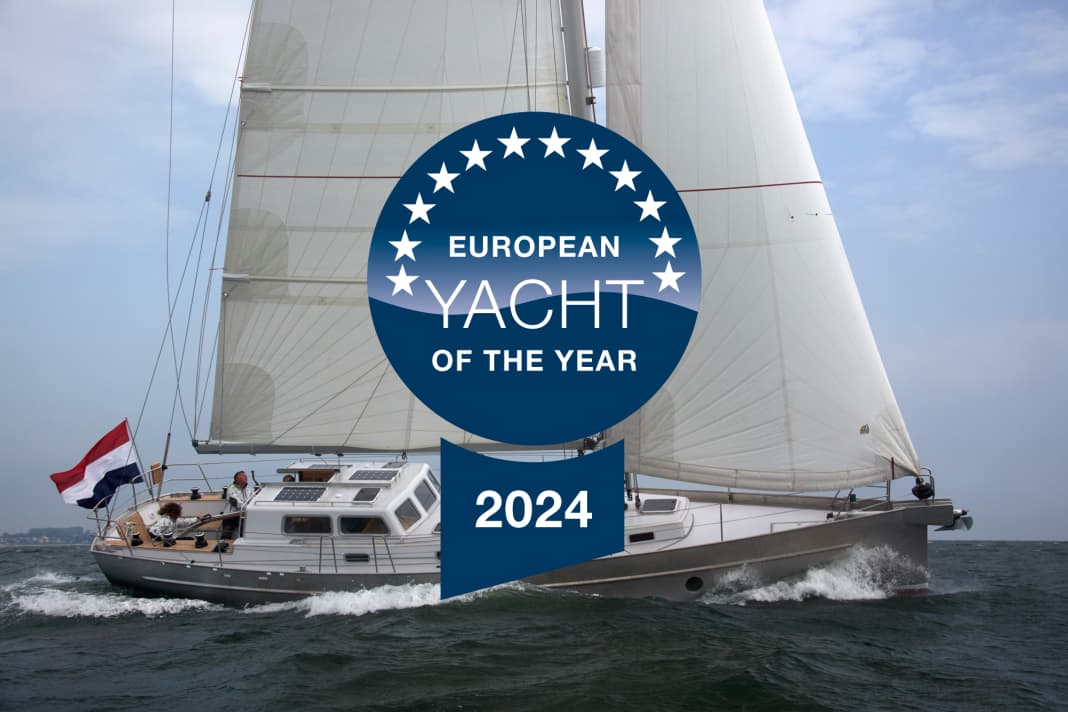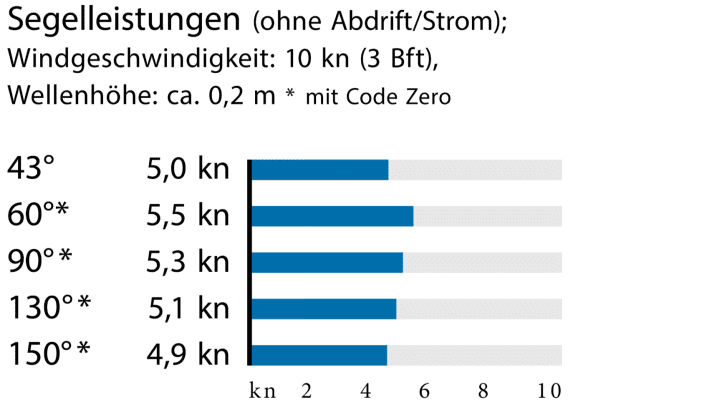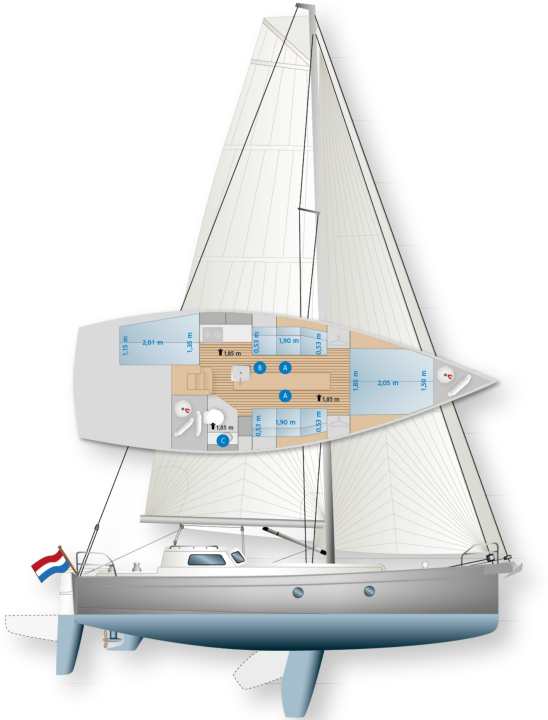





The first glance is surprising: That one in the crane runway at KM Yachtbuilders in Makkum hardly looks like the new Baby-Bestevaer, which is only 36 feet short. The ship here must be bigger. Perhaps this is simply because the lines of the 36-footer are the same as those of the yachts in the Bestevaer range, which are up to 70 feet long. In fact, today's test ship is not particularly large: it is only 10.95 metres long above deck. But the design principles are identical: straight ends for maximum waterline length and therefore speed, a rather small cockpit that is well protected behind the deckhouse, a high bulwark, a flat superstructure and that very special look of bright aluminium.
The original Bestevaer was 53 feet long. 45 feet was also okay for these aluminium boats, as the report in YACHT 8/2008 showed. But does the concept also work on less length? It can be assumed that at least a lot of thought has gone into it, because the first boat built is also the ship of Bestevaer designer and J-Class pope Gerard Dykstra. He is known for his good detailed solutions and his adherence to principles when it comes to sailing performance. Pleasingly, Mr Dykstra is on board for the trial run. He wants to know what we think of his latest work.
The first impression from the outside is certainly successful. The lines fit, but Dykstra sacrifices height on the inside. 1.85 metres is not necessarily a lot these days. However, the first thing that strikes you is the small cockpit. 1.35 metre short seat thwarts, the tiller, which simply needs a lot of space underway, even if it can be shortened to some extent, and the wooden plank aft as a bench: there is not a lot of space there. Master Dykstra had a very small crew in mind, and he designed everything with them in mind. This has been consistently realised and works well. When testing with up to five people on board, it gets cramped.
Huge table- the layout of the Bestevaer 36
The layout inside also fits perfectly: a large bed in the foredeck, separated from the saloon only by a curtain. Privacy is not important when travelling as a couple. The berth aft on the port side under the seat in the deckhouse can only be used by one person; if more guests come on board, they will have to sleep in the saloon. A double bed can be created on the port side between the outer wall and centreboard box, although it is only 1.90 metres long.
What catches the eye is the huge table for up to six people. This doesn't seem to make much sense in terms of the layout, but the centreboard box needs the space. The length of the centreboard and therefore the box inside provides the necessary stability under sail. This allows the 2.3-tonne annex to be lowered to 2.4 metres.
More yachts in the test:
At the aft end, a deep sink has been ideally positioned in the centre of the ship. The galley, which is very seaworthy, is located on the port side. It's a pity that the cooker, even if it's only the spirit version, is on the surcharge list. The wet room is to starboard - washbasin and WC, done. You could also take a shower in there, but the space seems very cramped. If you want more space in the wet room, you have to sacrifice the seat to starboard in the deckhouse and thus also the very skilfully positioned oil locker underneath. The deckhouse itself is 1.42 metres high inside, the two seats are comfortable and are ideal for keeping watch thanks to the excellent all-round visibility. What you won't necessarily do is spend time in it at anchor or in the harbour, because apart from sitting, you can't do anything here, not even lounging or lying down.
Propulsion and power generation on the aluminium explorer
On a Bestevaer, the deckhouse is used to stay at sea. Time to see how she behaves there. To do this, we first head out onto the IJsselmeer under engine power. A 15 kW Oceanvolt servoprop takes care of this on the test ship. Naturally, this cannot be heard or felt. With a third of its power, it brings the ship up to a good five knots. Together with the 30 kilowatt-hour battery pack, this is enough for around 30 nautical miles under engine power. The standard battery pack is half the size. A 29 hp Yanmar diesel engine is fitted as standard. If you want to drive electrically and choose the large energy storage unit, you will pay around 75,000 euros extra. A further 24,000 euros are added if you would like to have a 6 kW generator from Fischer Panda on board. If you don't want this, you can also upgrade to 43 kWh battery power. The servoprop recuperates while sailing.
Solar cells and a wind generator can also be installed to further charge the batteries. The Bestevaer will probably not be able to manage entirely without shore power or diesel converted into electricity by means of a generator if longer distances need to be travelled with engine assistance. However, as the generator can cope with HVO diesel, i.e. diesel made from vegetable oil, it is certainly possible to speak of a sustainable drive system. Keyword sustainability: aluminium is probably the most sustainable boat building material, as it consists of around 70 percent recycled material. The shipyard also uses materials that leave the smallest possible ecological footprint for wood, sails and fabrics, as well as rock wool insulation.
8 nodes under Code Zero- the sailing performance of the Bestevaer 36
The best ecological propulsion is wind! The mainsail rises on the halyards deflected into the cockpit. An age-appropriate electric winch helps with this. If the version with a flared top is chosen, the boat is fitted with backstays. The highlight: these are only needed when the wind is stronger. The flared sail head fits under the backstays in the first reef. When the main and genoa are in position - a self-tacking jib on a Hoyt boom is also possible - the wind blows at just eight knots. The 36 is travelling at around four knots at around 43 degrees to the true wind and is completely neutral on the rudder, with no pressure to be felt. Almost apologetically, designer Dykstra explains that such an open centreboard box always causes resistance under water. Unfortunately, this cannot be changed.
With ten knots of wind, the upwind speed increases to a good five knots. Later, when the display shows 15 knots in gusts, there is a pleasing response from the ship in the form of light rudder pressure. The Bestevaer then manages just under eight knots, albeit with code zero. What is noticeable under sail is the fiddly operation of the Antal clamps. They are semi-concealed on the coaming. Their release mechanism with release line is only active when there is tension on the line. This is very impractical with the mainsheet: if you want to slacken it, you first have to crank it to build up tension. A different solution should be found here.
Price: This is how much the compact aluminium yacht costs
In terms of operation, this is the only point that doesn't work well. Otherwise, the shipyard and designer have come up with some very nice details. Although the folding bathing platform is not particularly large, it fulfils its purpose perfectly - but costs an extra 6,500 euros.
Naturally, rope shackles are used wherever possible. This means that there is simply less corrosion-prone stainless steel on board. Another well thought-out detail: How do you create an anti-slip coating on aluminium? By sandblasting. This roughens the surface. No colour, no coating.
It remains to be seen how the market will accept the Bestevaer 36. With some equipment, the ship costs around 600,000 euros. A good 100,000 euros more than a larger Allures 40.9. The strict focus on small crews requires a willingness to compromise. The shipyard and designer were consistent in terms of build quality and sailing characteristics. The former is simply excellent, especially as far as the aluminium work is concerned, and the interior fittings are also good and seaworthy. She does what she should under sail. Another advantage: in bare aluminium and with an electric motor, the boat requires virtually no maintenance.
There are therefore enough aspects on the plus side, including those relating to sustainability. Added to this are the variable draught and the elaborate insulation, which lead to higher prices. Anyone who appreciates these things may find their personal dream boat in the 36.
The measured values for the Bestevaer 36 test




The Bestevaer 36 in detail

Technical data
- Designer:Gerard Dykstra
- CE design category: A/B
- Torso length:10,95 m
- Overall length (rudder at the bottom):12,05 m
- Waterline length:10,65 m
- Width: 3,80 m
- Draught (sword):0,70-2,40 m
- Mast height above WL:16,70 m
- Theor. torso speed:7.9 kn
- Weight: 8,8 t
- Ballast/proportion:2,3 t/26 %
- Großs. (Pin/Fathead):36,9/45,4 m²
- Furling genoa (105 %):28,2 m²
- machine (Yanmar):22 kW/29 hp
- Fuel tank:130 l
- Fresh water tanks (2):75 litres each
- Holding tank:50 l
- Batteries:1x 70 Ah + 2x 100 Ah
Equipment and prices
- Base price ex shipyard: 565.250 €
- Price ready to sail: 575.841 €
- Comfort price:610.879 €
How the prices shown are defined can be found here !
Standard equipment included in the basic price: 29 hp diesel engine, sheets, sailcloth, railing, navigation lights, battery, compass, sails, cushions, galley, bilge pump, toilet, fire extinguisher, holding tank with suction, fenders/mooring, anchor with chain, clear sailing handover
Hull and deck construction
- Seawater-resistant aluminium, 5 to 10 mm (keel sole)
- Two watertight bulkheads
- Insulation: rock wool (50 mm) and cork
- Aluminium 70 % recycled
Sail
- The code always remains attached or disappears in the anchor locker. The sheets are shot up the mast
- Powerful big: The almost six square metres more surface area of the Fathead provides the extra pressure that is good for the boat
- Optional: Genoa as a 95 per cent version on a Hoyt boom as a self-tacking jib. Backstays also come on board with the fathead main
Layout
If you can do without the oil locker and the starboard seat in the doghouse, a shower is available on request. However, with only 150 litres of fresh water on board, you should keep it short
Recuperation and batteries
- The electric motor can recuperate very efficiently
- In addition, the battery can be increased to up to 43 kWh. This then costs an extra 35,600 euros.
- Also possible: a 28.8-kWh battery pack (plus €18,450) and a 6-kW generator for €23,800
Solar energy
Solbian solar cells can be placed on the deck and pilothouse; the 4.2 square metres should ideally generate almost 1,000 watt peak. Surcharge: 10,000 euros
Attachments
- Hoe on the propeller: The boat can stand on the trailer. But propulsion and recuperation suffer somewhat due to the obstacle
- The centreboard extends completely into the hull. This means that nothing sticks to it and the ship remains stable
No corrosion
To avoid contact between aluminium and stainless steel as far as possible, the ship is made of aluminium wherever possible
Cooling volume
- Refrigerator 35 l
- No freezer compartment
Shipyard and distribution
- KM Yachtbuilders
- De Stienplaat 7
- 8754 HE Makkum, Netherlands
- www.kmy.nl
YACHT review of the Bestevaer 36
A perfectly thought-out mini blue water yacht. Gerard Dykstra's experience is clearly visible everywhere on board, and the metalwork is of the very high quality typical of KMY. The 36 sails well enough for a boat of this calibre. The cost: The price is over 100,000 euros higher than that of the Ovni 370.
Design and concept
- + Very robust construction
- + Good insulation
- + Variable draught possible
- + Well-protected cockpit
- - High price
Sailing performance and trim
- + Good light winch properties
- + Very good balance
- + Versatile rig
Living and finishing quality
- + Deckhouse concept
- + Many well thought-out details
- +/- Open interior
Equipment and technology
- + Modern drive concept optionally available
- + Very high-quality fittings
- + Simple but effective anti-slip deck
Gerard Dykstra: "We needed a smaller boat!"
After 70,000 nautical miles with his Bestevaer 53, Gerard Dykstra is taking it a little easier with his new 36
Mr Dykstra, normally the boats are getting bigger and bigger, why not yours?
That's true. Our strength wanes with age, so we had to adapt the boat because we wanted to continue operating everything by hand. We wanted a complete cruising boat, but on 36 feet and with a variable draught.
That costs performance...
Yes, but that is limited. It can still sail fast, but it's not a 53. She was really fast in almost all conditions. But we also have other plans now, so 36 feet fits very well.
What are they?
We travelled to all sorts of far-flung destinations on the previous boat, but never actually travelled around here. We want to go to the mudflats, really anywhere, maybe as far as Denmark or the Baltic Sea.
And the fridge is also new ...
(Laughs) Yes, I seem to become more willing to compromise with age.

